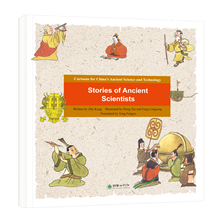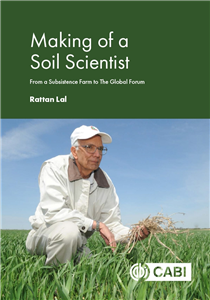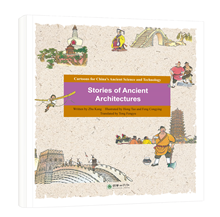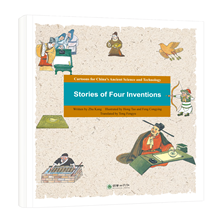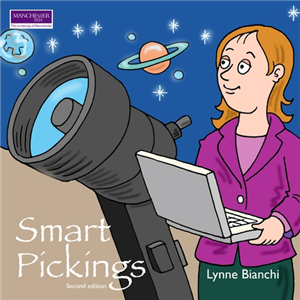Your Search Results
-
Promoted Content
Ancient Chinese Technology in Comics: Stories of Ancient Scientists
by Zhu Kang(texts), Hong Tao and Feng Congying(illustration)
This is a set of storytelling comic strips for children aged 6 to 8. Including stories about famous ancient Chinese scientists and their notable scientific achievements, the series shows episodes in the history of science and technology in China with simple pictures and vivid texts. It is intended to meet the reading needs of children, so as to acquaint them with the long-standing scientific and technological civilization of China. This series consists of four volumes: Stories of Ancient Scientists introduces the biographies and major achievements of four great ancient scientists, namely, Zhang Heng, Zu Chongzhi, Monk Yixing and Xu Xiake. Stories of Four Great Inventions shows the emergence and development of the four ancient Chinese inventions that has influenced the progress of human civilization. Stories of Ancient Medical Scientists tells the life stories of four famous medical scientists, including Bian Que, Hua Tuo, Wang Weiyi, and Li Shizhen. Stories of Ancient Architectures describes the great achievements of ancient Chinese architecture, as well as typical ancient Chinese architectural styles and construction techniques.
-
Promoted Content
Ancient Chinese Technology in Comics: Stories of Ancient Medical Scientists
by Zhu Kang(texts), Hong Tao and Feng Congying(illustration)
This is a set of storytelling comic strips for children aged 6 to 8. Including stories about famous ancient Chinese scientists and their notable scientific achievements, the series shows episodes in the history of science and technology in China with simple pictures and vivid texts. It is intended to meet the reading needs of children, so as to acquaint them with the long-standing scientific and technological civilization of China. This series consists of four volumes: Stories of Ancient Scientists introduces the biographies and major achievements of four great ancient scientists, namely, Zhang Heng, Zu Chongzhi, Monk Yixing and Xu Xiake. Stories of Four Great Inventions shows the emergence and development of the four ancient Chinese inventions that has influenced the progress of human civilization. Stories of Ancient Medical Scientists tells the life stories of four famous medical scientists, including Bian Que, Hua Tuo, Wang Weiyi, and Li Shizhen. Stories of Ancient Architectures describes the great achievements of ancient Chinese architecture, as well as typical ancient Chinese architectural styles and construction techniques.
-
 Trusted Partner
October 2025
Trusted Partner
October 2025Making of a Soil Scientist
From a Subsistence Farm to The Global Forum
by Rattan Lal
Rattan Lal is ranked No. 1 globally and in the U.S. among agricultural scientists (Plant Science and Agronomists) by Research.com on the basis of the number of scientific citations and his discipline H-index. He has been awarded The World Soil Prize, The Japan Prize, The World Food Prize, The Arrell Innovation Prize, and the Padma Shri Award. This book describes Rattan Lal's professional journey from a subsistence farm in India to working on global fora as a soil scientist. It discusses the challenges and opportunities of his soil-centric approach to global issues faced in the 21st century, emphasizes the need for revisiting the Green Revolution approach, and making agriculture an integral part of the solution to restoring soil health, addressing climate change, and promoting sustainable development. This book will be of interest to students and researchers in soil science, agronomy, natural resource management and sustainable development. This book combines an exploration of the value of a soil-centred philosophy when addressing sustainability issues together with descriptions of the challenges of an international scientific career.
-
 Trusted Partner
Trusted Partner
-
 Trusted Partner
BiotechnologyJune 2002
Trusted Partner
BiotechnologyJune 2002Farmers, Scientists and Plant Breeding
Integrating Knowledge and Practice
by David A Cleveland, Daniela Soleri
The purpose of this book is to examine the nature of and relationship between the knowledge of farmers and of scientists, and how these can be best integrated in plant breeding. In the past, farmers' knowledge of local biodiversity has often been underutilized, but currently there is an increased recognition of the importance of farmer participation or collaboration.
-
 Trusted Partner
Trusted Partner
-
 Trusted Partner
September 2020
Trusted Partner
September 2020Cartoon Nobel Scientist: Physics Prize
by Pang Le
The Nobel Prize is generally regarded as the most important award in all award fields worldwide. The Nobel Prize has led mankind to science and the future. The content of this book relates to how the Nobel Prize in Science was selected? How did the Nobel Prize and a group of brilliant geniuses affect the world? Are there competitions, contradictions and conflicts among scientists who have won the Nobel Prize? The author combined original two-dimensional cartoons and relaxed language to show the nature of the research work of world-class scientists such as Einstein and Fermi from the perspective of popular science. He has made significant contributions in changing our world. His and personal experience, the main problems encountered, and his exploration and critical spirit. This book combines legends, stories, theoretical analysis, scientific history, etc., and takes you to the most coveted and persuasive awards of this era-those little-known winners of Nobel Prizes and outstanding geniuses thing.
-
Agriculture & farmingJanuary 2008
Underutilized and Underexploited Horticultural Crops: Vol 04
by K.V. Peter
There is Global concern on shrinking food base depending on a meager three crops-wheat, rice and maize-.New Crops are to be encouraged to fit into the changing food habits, life styles and above all climate change. Underutilized Horticultural Crops are getting attention world around. The High Impact Journal HortScience reviewed vol. II Underutilized and Underexploited Horticultural Crops and reported its global value. The series projects the nutritional values, ecological compatibility, fitness to ecological niches and above all optimum uses of natural resources like water, energy, space and time. Volume 4 deals with edible plant foods in Africa, African Leafy Vegetables, Amaranths, Chilies, Annual Drumstick, Clove bean, Cluster bean, Curry leaf, Ivy Gourd, Snap melon, Sweet Gourd, Teasles Gourd, Tree borne vegetables, Fruits of North Eastern Region, Dragon Fruit, Wood apple, Strobilanthes, Seed Spices, Yam bean and Trees for Energy. Twenty s in the 4th volume are compiled by the Eminent Scientists in the respective crops. The volume 4 envisages a world free from hunger and under nutrition and full of health and wellness.
-
Natural disastersAugust 2015
Droughts in Agricultural Production
Monitoring & Management
by G.G.S.N. Rao
Drought is considered to be a normal feature of climate especially in tropical countries where occurrence of periods of dry weather during rainy season is common. Virtually droughts can occur in all climates and they can also be witnessed when the air temperatures are higher than the normal for a longer period that increases both evaporation and water deficit. 1. The first deals with the introduction to the topic, historical evidences of drought and famines in India. 2. The definition of droughts, criteria for classification of droughts, drought indices based on rainfall, climate derivatives and remote sensing are covered under two. 3. Information on climate change with respects to climate trends, projections on temperature and rainfall at global as well at national level, consequences of climate change on droughts are presented in there. 4. Approaches on drought monitoring, adopted by various countries, international cooperation in drought monitoring and drought monitoring mechanism in India are presented in four. Decision Support Systems and applications of GIS for drought monitoring are also covered in this . 5. World food production and its variability, the impact of phenomenal drought during 2009 on food grain production in different countries, impacts of droughts on livestock, milk and fisheries production are covered under five. 6. Global surface waters, availability of surface waters in India, influence of drought on fauna and flora of surface waters and global warming on water resources at global and national level is discussed in – six. 7. Drought management strategies, drought planning and preparedness action plans at global as well at national level, indigenous knowledge on drought management, astrological techniques in weather forecasting and traditional wisdom on management of droughts in different nomadic communities in Asia and Africa are covered in seven. eight carries the conclusion of the entire book. Book will be useful to the students and research scholars of Agrometeorology, Meteorology and Geography and all Research Scientists dealing with NRM.
-
Ancient Chinese Technology in Comics: Stories of Ancient Architectures
by Zhu Kang(texts), Hong Tao and Feng Congying(illustration)
This is a set of storytelling comic strips for children aged 6 to 8. Including stories about famous ancient Chinese scientists and their notable scientific achievements, the series shows episodes in the history of science and technology in China with simple pictures and vivid texts. It is intended to meet the reading needs of children, so as to acquaint them with the long-standing scientific and technological civilization of China. This series consists of four volumes: Stories of Ancient Scientists introduces the biographies and major achievements of four great ancient scientists, namely, Zhang Heng, Zu Chongzhi, Monk Yixing and Xu Xiake. Stories of Four Great Inventions shows the emergence and development of the four ancient Chinese inventions that has influenced the progress of human civilization. Stories of Ancient Medical Scientists tells the life stories of four famous medical scientists, including Bian Que, Hua Tuo, Wang Weiyi, and Li Shizhen. Stories of Ancient Architectures describes the great achievements of ancient Chinese architecture, as well as typical ancient Chinese architectural styles and construction techniques.
-
Ancient Chinese Technology in Comics: Stories of Four Inventions
by Zhu Kang(texts), Hong Tao and Feng Congying(illustration)
This is a set of storytelling comic strips for children aged 6 to 8. Including stories about famous ancient Chinese scientists and their notable scientific achievements, the series shows episodes in the history of science and technology in China with simple pictures and vivid texts. It is intended to meet the reading needs of children, so as to acquaint them with the long-standing scientific and technological civilization of China. This series consists of four volumes: Stories of Ancient Scientists introduces the biographies and major achievements of four great ancient scientists, namely, Zhang Heng, Zu Chongzhi, Monk Yixing and Xu Xiake. Stories of Four Great Inventions shows the emergence and development of the four ancient Chinese inventions that has influenced the progress of human civilization. Stories of Ancient Medical Scientists tells the life stories of four famous medical scientists, including Bian Que, Hua Tuo, Wang Weiyi, and Li Shizhen. Stories of Ancient Architectures describes the great achievements of ancient Chinese architecture, as well as typical ancient Chinese architectural styles and construction techniques.
-
 Trusted Partner
June 2014
Trusted Partner
June 2014Personal China Dream
by Tianbin Zhang(Editor-in-chief)
A hundred representatives from various fields, scientists, celebrities and ordinary people, they are all working hard for their own dreams, which are closely linked to the development of the nation. It makes the “China Dream” concept have an abundant and specific meaning, and also have an attractive appeal.
-
 Trusted Partner
Children's & YAApril 2024
Trusted Partner
Children's & YAApril 2024Smart Pickings
2nd Edition
by Lynne Bianchi
Smart Pickings (2nd Edition) further engages young readers with the world of science. It promotes talk between children, their classmates, teachers, parents, family and friends. The book introduces a range of diverse and inspirational scientists who have or are making a difference through their innovations and research. A book to encouraging us all to wonder, ask questions and ask 'Who are they?', 'How might I be like them?'
-
 Trusted Partner
EconomicsJune 2007
Trusted Partner
EconomicsJune 2007Agricultural Biotechnology and Intellectual Property
Seeds of Change
by Edited by Jay Kesan
Scientists are becoming progressively more involved in developing methods for increasing agricultural productivity and designing plants with certain qualities. As such, genetic engineering has given plant breeders a means to exercise property rights over different varieties of plants. This has created many implications and given way to much controversy, with most objections being raised against the idea of owning life. With the use of comparative studies, this book discusses the legal, agribusiness and public policy issues that connect intellectual property protection with advancements in agricultural biotechnology.
-
Agriculture & farmingJune 2022
Transfer of Farm Technology and Communication Skills
by C. Satapathy & M.P. Nayak
Transfer of farm Technology is a complex process involving social sciences, scientists, farmers and extension experts. To transfer farm technology each and every actor in the process need be familiar with communication skill. In Extension Education greater emphasis is given in teaching, research and field extension work. The present book is written out of such realization. The book is designed for use by extension scholars, scientists and field professionals. The book may help to be good communicators for farmers residing in rural areas.
-
 Trusted Partner
Zoology & animal sciencesAugust 2006
Trusted Partner
Zoology & animal sciencesAugust 2006Animal and Human Health and Welfare
A Comparative Philosophical Analysis
by Edited by Lennart Nordenfelt
Scientists within human and animal science have extensively discussed the philosophy of medicine, but never have both sides communicated on their concepts of health, quality of life and welfare, with each other. This book aims to help clarify the difficult but central notions of health and welfare by comparing the human and animal variants of these concepts. Split into three parts this book starts by presenting a background of some of the major theories of human health and welfare, followed by a detailed discussion of theories on animal welfare and health. While the final part of the book tests a comprehensive conceptual framework of a holistic kind, which focuses on the individual's ability to achieve its vital goals.
-
HorticultureNovember 2017
Tropical Fruits
Vol.02: Fruit Science Culture & Technology
by J.S. Bal
The various aspects of fruit cultivation mainly covered are nutritive and cultural significance; origin, history, and distribution ; taxonomical and botanical description ; climatic and soil adaptability; propagation technology and rootstocks; plant and fruit physiology; recommended and popular cultivars; soil cultural practices technology - water need, nutritional need, weed control, inter culture; plant cultural practices technology- training and pruning, fruit thinning ,fruit quality improvement , use of plant growth regulators; special problems; harvesting and production of fruits; post-harvest fruit technology; insect-pests and diseases management ; marketing and export potential. Section-1 covers 2 leading sub- tropical fruits of the country. Similarly, section- 2 covers 4 and section-3 covers 6 sub- tropical fruits in order of their importance. Scientists working in different Universities/ Institutions and Research Stations have contributed chapter on fruit crops in their respective areas of specialization. The book will be highly beneficial to the graduate and post-graduate students in Fruit Science, fruit growers, scientists and extension workers.
-
HorticultureJanuary 2018
Temperate Fruits
Vol.04: Fruit Science Culture & Technology
by J.S. Bal
The various aspects of fruit cultivation mainly covered are nutritive and cultural significance; origin, history, and distribution; taxonomical and botanical description; climatic and soil adaptability; propagation technology and rootstocks; plant and fruit physiology; recommended and popular cultivars; planning and planting; soil cultural practices technology - water need, nutritional need, weed control, inter culture; plant cultural practices technology - training and pruning, fruit thinning ,fruit quality improvement, use of plant growth regulators; special problems; harvesting and production of fruits; post-harvest fruit technology; insect-pests and diseases management; marketing and export potential. Section-1 cover 1; section- 2 covers 5; section-3 covers 4 and section 4 cover 1 temperate fruits in order of their importance. Scientists working in different Universities/Institutions and Research Stations have contributed chapter on fruit crops in their respective areas of specialization. The book will be highly beneficial to the graduate and post-graduate students in Fruit Science, fruit growers, scientists and extension workers.
-
HorticultureMarch 2017
Sub-Tropical Fruits
Vol.03: Fruit Science Culture & Technology
by J.S. Bal
The various aspects of fruit cultivation mainly covered are nutritive and cultural significance; origin, history, and distribution; taxonomical and botanical description; climatic and soil adaptability; propagation technology and rootstocks; plant and fruit physiology; recommended and popular cultivars; planning and planting: soil cultural practices technology - water need, nutritional need, weed control, inter culture; plant cultural practices technology- training and pruning, fruit thinning, fruit quality improvement, use of plant growth regulators; special problems; harvesting and production of fruits; post-harvest fruit technology; insect-pests and diseases management ; marketing and export potential. Section-1 covers 2 leading sub- tropical fruits of the country. Similarly, section- 2 covers 4 and section-3 covers 6 sub- tropical fruits in order of their importance. Scientists working in different Universities/ Institutions and Research Stations have contributed chapter on fruit crops in their respective areas of specialization. The book will be highly beneficial to the graduate and post-graduate students in Fruit Science, fruit growers, scientists and extension workers.
-
Agriculture & farmingJanuary 2012
Microbial Diversity and Functions
by D. Joseph Bagyara ,K.V.B.R. Tilak & H.K.Kheri
The book contains 31 articles written by distinguished scientists of the country having expertise in dealing with the microbes and exploiting their potential for the benefits of mankind. The articles included in the book are thought provocating and deals with: o the topics of Taxonomy, Diversity and Applications of VAM fungi in different Ecosystems o Applications of Microbial Technology for Treatment of effluents of a Gelatine Factory, Biodiversity of Mycotoxigenic Fungi and Trichoderma, o Useful microbes of Mangrove Ecosystem, Extremophiles, PGPRs, Phytotoxins, Litter decomposition, Biopesticides, Botanical Pesticides, biofertilizers and so many others including major concerns about the Evolution and Conservation of Microbial Biodiversity. o All the articles written by the authors are original, timely and appropriate.




